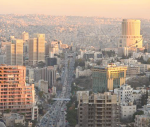You are here
Al Sabeel prints final edition, goes all digital
By Maram Kayed - Dec 31,2019 - Last updated at Dec 31,2019
AMMAN — The opposition-sided, Islamist daily Al Sabeel newspaper will suspend its printed version as of December 31, beginning the new year in its online form only.
“For the first time since its inception on October 31, 1993, and due to circumstances beyond its control, Al Sabeel paper-edition will be suspended from circulation as of today,” wrote Atef Joulani, the newspaper’s editor-in-chief, in his daily column.
For 26 years and two months, the newspaper “has been publishing without interruption except on holidays… Today, it finds itself forced to stop,” he added.
Most columnists and reporters at the paper pinned the suspension on the “difficult economic situation of press media in Jordan and abroad, the effects of which almost no newspaper has survived,” as worded by Ali Saadeh, another columnist for Al Sabeel.
Media and communication specialist Bayan Tal told The Jordan Times over the phone that all print media is facing extinction unless it follows the media scene’s trend and goes digital.
“Online is where people are, and that is where they read their news. Media consumption has changed and newspapers should adapt to that if they want to stay relevant and survive,” she added.
In spite of the suspension of the print version of Al Sabeel, its website will continue on.
“It is neither goodbye nor farewell, but rather a shift in the communication and meeting mechanism between us and our readers to a more interactive mode,” said the chief editor.
Rakan Saayah, president of the Jordan Press Association said in a post via his official Facebook account: “The end of Al Sabeel’s paper publication is a source of sadness and regret, as it is one of the professional newspapers that we cherish.”
“We all know that all daily newspapers, without exception, suffer from very difficult financial conditions. Newspaper departments, as well as the state, have a responsibility to find a way to support national newspapers and maintain their independence,” he added.
Digitising a newspaper can be “quite a process”, according to Tal, as it is expensive and time-consuming, requiring the training of journalists on multiple new platforms.
However, digitalisation does not mean that the print media have lost their value, according to Saadeh. He draws on American columnist Ted Rall’s ideas that people will still buy a newspaper if it has in-depth analyses of recent events.
“Of course, people will not buy a newspaper if it only reports an event the way social media did the day before. However, if the newspaper offers analyses, infographics and new angles, they will, which is why big newspapers like The New York Times and The Washington Post have not only not shut down, but also have made more profits in recent years,” Saadeh stated.
Tal reiterated the fact that a newspaper, even if it decides to go online, must focus on content in addition to form.
“In the midst of social media where an event is reported the very same instant it happens, a newspaper needs to focus on infographics, pictures, cartoons and good, objective content. That is why official media cannot die or be replaced by anything else,” she added.
Related Articles
AMMAN — “Going back to printing newspapers is plausible.
AMMAN — Amidst difficult financial conditions and the decline in advertising and distribution, newspapers in Jordan should focus on breathin
AMMAN — The Islamist Al Sabeel Daily on Thursday announced that it will be published five days a week instead of seven.















